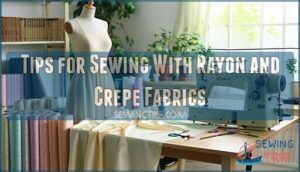This site is supported by our readers. We may earn a commission, at no cost to you, if you purchase through links.

This temperamental fabric shifts like quicksand under your presser foot, creating uneven hems and frayed edges. You’re not losing your mind—crepe’s loose weave and slippery texture naturally resist cooperation.
The key lies in using sharp microtex needles, reducing presser foot pressure, and stabilizing edges with stay-stitching before construction. French seams work better than standard ones, while tissue paper beneath your fabric prevents feed dog snags.
Master these fundamentals, and you’ll discover techniques that transform this challenging fabric into stunning, professional-looking garments.
Table Of Contents
- Key Takeaways
- Common Issues When Sewing With Crepe Fabric
- Tips for Sewing With Crepe Fabric
- Choosing The Right Needle for Crepe Fabric
- Techniques for Sewing Straight Seams With Crepe Fabric
- Overcasting Techniques for Crepe Fabric
- Different Seam Types for Working With Crepe Fabric
- Preparing Your Fabric Before Sewing
- Tips for Sewing With Rayon and Crepe Fabrics
- Troubleshooting Common Sewing Issues With Crepe Fabric
- Final Tips and Recommendations for Sewing With Crepe Fabric
- Frequently Asked Questions (FAQs)
- Conclusion
Key Takeaways
- Use microtex needles and reduce presser foot pressure – You’ll prevent skipped stitches and fabric stretching by switching to sharp 70/10 or 80/12 microtex needles and lowering your machine’s pressure settings to work with crepe’s delicate structure.
- Stabilize before cutting and sewing – You can control crepe’s slippery nature by applying light spray starch before cutting, then use stay-stitching along curved edges immediately after cutting to prevent unwanted stretching during construction.
- Choose French seams over standard seams – You’ll eliminate fraying issues by using French seams that completely encase raw edges, making them ideal for crepe’s loose weave that tends to unravel quickly.
- Support fabric during sewing with tissue paper – You can prevent feed dog snags and maintain even fabric feeding by placing tissue paper beneath your crepe while sewing, then tearing it away after stitching is complete.
Common Issues When Sewing With Crepe Fabric
Working with crepe fabric can feel like wrestling with silk scarves in a windstorm—the slippery texture and delicate weave create unique sewing challenges that frustrate even experienced seamsters.
Crepe fabric turns even simple seams into a slippery challenge that demands patience and precision.
You’ll encounter four main issues: puckering and stretching from the fabric’s unstable structure, skipped stitches caused by needle deflection, hemming difficulties due to the slippery nature, and seams that unravel faster than you can finish them.
The challenges include hemming difficulties due to the slippery nature of the fabric, which can lead to a variety of problems in the sewing process.
Puckering and Stretching
Most crepe fabric problems stem from its slippery, unstable nature that fights against your machine’s fabric tension settings.
This delicate material stretches and puckers when handled improperly, creating frustrating seam stability issues that plague even experienced sewers.
Here’s how to tame crepe behavior:
- Stabilize before cutting – Apply light spray starch to control fabric relaxation and prevent differential shrinking during handling
- Adjust machine tension – Reduce presser foot pressure and use a walking foot to maintain even feed without stretching
- Choose proper thread – Select fine polyester or silk thread that won’t overpower the fabric’s delicate weave structure
The key lies in understanding that crepe wants to move and shift naturally.
Work with its characteristics rather than against them by using gentle handling techniques and appropriate machine settings for ideal results.
Skipped Stitches
Nothing’s more frustrating than watching your machine skip stitches while sewing crepe—it’s like your needle can’t find its rhythm with this slippery fabric.
The tight weave of crepe requires precise needle selection and proper thread tension to achieve consistent stitches.
Switch to a Microtex needle (sizes 80/12 or 90/14) for silk crepe’s dense weave. These sharp needles penetrate cleanly without deflecting.
Adjust your thread tension to 3-5 and reduce stitch length to 2mm. Light starching before cutting stabilizes the fabric tension, preventing the weave from shifting during sewing.
- Test your tension adjustment and needle size on fabric scraps before starting your project
Difficulty in Hemming
Hemming crepe fabric feels like wrestling with silk pajamas—everything slides around.
Combat fabric slippage by using sharp microtex needles and lightweight thread that won’t add bulk.
Apply spray starch before cutting to add temporary stability.
When hemming, use tissue paper underneath for support, then tear it away, and consider hand-basting to control distortion better than pins alone.
These stabilizer options prevent the frustrating puckering that makes crepe sewing challenges so notorious.
Unraveling Seams
Through proper seam reinforcement, you’ll prevent crepe’s notorious tendency to unravel at the worst possible moments.
This delicate fabric demands strategic edge finishing techniques that lock those loose threads in place before they create headaches.
- Apply fray check liquid along cut edges before sewing for instant fabric stabilization
- Use French seams to completely encase raw edges within the seam allowance
- Overcast stitch or serge seam edges immediately after cutting to prevent fraying
- Choose silk thread for thread selection that matches crepe’s delicate structure
- Increase your seam allowance to ⅝ inch minimum for better edge finishing control
Tips for Sewing With Crepe Fabric
Now that you’ve identified the common challenges with crepe fabric, let’s tackle them head-on with proven techniques.
These eight expert tips will transform your crepe sewing from frustrating to flawless, giving you the confidence to handle even the most slippery fabrics.
Stay-stitching for Stability
Stay-stitching works like an insurance policy for crepe fabric—protecting vulnerable edges before they stretch out of shape.
Smart preparation beats fabric frustration every time.
Apply this Fabric Stability technique immediately after cutting, stitching 1/8 inch inside seam allowances with shortened stitch length.
| Staystitching Element | Technique |
|---|---|
| Stitch Placement | 1/8 inch inside seam allowance |
| Stitch Length | 1.5-2mm for fabric stabilizers |
| Priority Areas | Necklines, armholes, curved seams |
| Timing | Immediately after cutting pieces |
This essential Sewing Technique prevents the dreaded "crepe stretch syndrome" during construction, maintaining proper fit.
To guarantee professional results, understanding garment construction techniques is vital for working with delicate fabrics like crepe.
Using a Foot With Dual Feed
When sewing crepe fabric, everything changes once you attach a dual feed foot to your machine.
This specialized attachment transforms your sewing experience by coordinating both the upper and lower feed mechanisms to work in perfect harmony.
- Dual Feed systems prevent the top fabric layer from sliding ahead of the bottom layer
- Fabric Control becomes substantially easier when both feeds grip simultaneously
- Even Feeding eliminates the common problem of fabric stretching during stitching
- Stitch Regulation improves dramatically as layers move together at identical speeds
- Feed Mechanism coordination reduces puckering and maintains consistent seam allowances
A dual feed foot essentially acts like having an extra pair of hands guiding your crepe fabric sewing project.
The synchronized feeding action tackles fabric feeding issues head-on, making sewing slippery fabrics much more manageable.
You’ll notice immediate improvements in seam quality and reduced frustration when working with challenging crepe materials.
Using Sharp Needles and a 0mm Plate
Sharp needle selection makes all the difference when tackling sewing crepe challenges. Choose a 60/8 microtex needle for silk crepes—these sharp edges cut cleanly through delicate fibers without snagging.
Pair your needle selection with a 0mm throat plate for maximum fabric support around the needle hole. This plate adjustment prevents crepe from being pushed down into larger openings.
Fine thread weighs 100-weight, reducing bulk while maintaining thread control. Adjust fabric tension settings since crepe’s slippery nature requires different pressure than cotton.
Test these combinations on scraps first. Understanding the correct needle settings for fabric is essential for achieving professional results with various fabrics, including crepe.
Using Woven Interfacing
When working with delicate crepe fabric, selecting appropriate interfacing types becomes vital for fabric stabilization without compromising drape.
Lightweight woven interfacing provides excellent seam reinforcement while maintaining the fabric’s natural flow. Apply fusible woven interfacing using low to medium heat, carefully following the fabric’s grain direction.
This interface material prevents puckering during sewing crepe challenges while preserving the textile’s characteristic movement. For crepe fabric sewing tips, choose tricot-backed varieties that offer support without stiffening.
Match your interfacing to the crepe’s fiber content for ideal crepe fabric stabilization. These cutting techniques guarantee your garment maintains professional results while addressing common sewing crepe difficulties effectively.
Understanding the role of woven interfacing fabric is key to achieving the desired texture and stability in your sewing projects, ensuring a successful outcome with delicate crepe fabric and proper seam reinforcement.
Utilizing an Edge-stitch Foot
Precision becomes your ally when working with slippery crepe fabric.
An edge-stitch foot transforms challenging seam finishing into manageable tasks by providing consistent fabric guidance along raw edges.
This specialized foot features a metal guide that maintains perfect alignment, preventing crepe from shifting during stitch regulation.
You’ll achieve professional results with improved crepe handling as the foot controls fabric movement.
Edge stitching becomes effortless when your machine’s foot adjustment accommodates crepe’s delicate nature.
The guide eliminates guesswork, delivering clean, straight seams every time.
Master this essential crepe fabric sewing tip for flawless edgestitch foot performance and achieve professional results with improved crepe handling and consistent fabric guidance.
Sewing a Line of Stitching Before Pressing a Hem
Creating a guiding stitch before pressing your hem transforms unruly crepe into manageable fabric.
This Stitch Control technique involves sewing a straight line along your intended fold line using a regular stitch length.
The thread acts as a roadmap for Hem Stability, preventing the slippery material from shifting during pressing.
When sewing crepe, this staystitch method provides essential Fabric Handling control.
Your iron will follow this stitched guide perfectly, creating crisp, professional hems.
This Crepe Preparation step eliminates guesswork and reduces frustration during hemming delicate fabrics.
Pressing Seams Before Pinning
Proper seam pressing transforms challenging crepe fabric into manageable material.
Before you pin sections together, press seams open using gentle finger pressure or a cool iron with pressing cloth.
This fabric stabilization step relaxes crepe’s fibers, preventing shifting during subsequent stitching.
Smart sewing preparation means pressing at each construction stage—it’s your secret weapon for professional results.
These pressing techniques create stable foundations that make crepe handling surprisingly straightforward, and by doing so, you ensure professional results with gentle finger pressure.
Hand-Basting Tricky Areas
Hand-basting provides ultimate fabric control when tackling crepe’s trickiest areas like curves and darts. This time-tested technique prevents costly mistakes while ensuring seam security throughout your project.
- Use contrasting thread for clear visual guidance during machine stitching
- Focus handbasting on curved seams, armholes, and complex dart formations
- Apply gentle tension management to avoid stretching delicate crepe fibers
- Staystitch bias edges before basting for maximum stability and control
By following these steps, you can ensure a professional finish and avoid common pitfalls associated with working with crepe, ultimately achieving seam security throughout your project.
Choosing The Right Needle for Crepe Fabric
Selecting the right needle transforms your crepe sewing experience from frustrating to smooth.
The needle type you choose directly impacts stitch quality and prevents common problems like skipped stitches and fabric damage.
Microtex Vs. Ballpoint Needles
The needle comparison between Microtex and ballpoint needles dramatically affects your crepe sewing success.
Microtex needles feature razor-sharp points that penetrate tightly woven crepe cleanly, preventing fabric slip and maintaining sewing precision. Their fine points create minimal holes while ballpoint needles, designed for knits, can push crepe fibers aside causing skipped stitches.
Choose Microtex size 70/10 with fine thread for maximum needle durability and flawless results. For maximum results, consider the needle size guidelines to guarantee the best fit for your fabric.
Adjusting Feed Dogs
Lowering your sewing machine’s feed dog pressure prevents crepe from stretching as it passes through.
Most machines feature adjustable Feed Dog Settings – reduce pressure to "1" or "2" for delicate fabrics.
This Fabric Tension adjustment lets the material flow naturally without distortion.
Proper Feed Control through Dog Teeth Adjustment maintains consistent fabric movement, preventing differential shrinking during Sewing Machine Calibration for ideal crepe handling.
Trying Silk Thread
Once you’ve adjusted your feed dogs, try using silk thread for sewing crepe.
Its smooth surface glides through delicate weaves, reducing puckering and skipped stitches.
Here’s why silk thread benefits your crepe sewing techniques:
- Maintains consistent thread tension for neat seams
- Fine thread weight prevents bulky stitches
- Soft finish minimizes fabric distortion during sewing
Choose silk thread for precision.
Techniques for Sewing Straight Seams With Crepe Fabric
Achieving perfectly straight seams with crepe fabric requires the right combination of sewing tools and fabric stabilization techniques.
Your needle choice matters, but proper preparation prevents most alignment issues.
Success comes from controlling crepe’s natural tendency to shift during stitching.
Use these proven sewing techniques:
- Apply spray starch to washable crepe before cutting for temporary stabilization
- Pin closely along seam lines using sharp silk pins to prevent fabric movement
- Install a straight stitch needle plate to support lightweight fabric and reduce flagging
- Mark seam lines with removable chalk for precise alignment on curved or bias cuts
When sewing crepe, gentle guidance beats forceful handling every time.
A walking foot prevents uneven feeding while maintaining consistent tension.
Test your settings on fabric scraps first—this simple step saves frustration later.
Keep your presser foot pressure light to avoid warping the delicate fibers during stitching.
Overcasting Techniques for Crepe Fabric
Overcast stitching keeps crepe edges from turning into a frayed mess while preserving that beautiful drape you’re after.
Start with a stretch overcast stitch set to 5mm width and 2.5mm length—this combination provides excellent fray prevention without adding bulk.
Your overcast foot’s center bar becomes your best friend here, guiding thread smoothly around delicate edges.
Choose fine polyester thread and a sharp Microtex needle (size 70/10) for clean stitches that won’t snag crepe’s textured surface.
Before overcasting, lightly spray edges with starch for fabric stabilization—this prevents the slippery material from shifting under your presser foot.
Test sewing tension on scraps first; crepe finishing requires lighter pressure than regular fabrics.
Keep stitches perpendicular to the edge, maintaining steady speed to avoid puckering.
For curved seams, hand-baste first, then overcast for professional edge binding results that won’t compromise your garment’s fluid movement.
Different Seam Types for Working With Crepe Fabric
You’ll face less frustration when you choose the right seam types for crepe fabric sewing techniques.
French Seams work beautifully by encasing raw edges completely, preventing the notorious fraying that plagues crepe projects.
These seams create a clean finish that withstands multiple washes without unraveling.
Flat Seams distribute stress across wider areas, making them ideal for garments requiring durability.
Bound Seams using bias tape offer professional-looking seam finishes while controlling fraying effectively.
For delicate areas, try Blind Hems that maintain crepe’s flowing drape without visible stitching lines.
Whipstitch techniques secure edges quickly on temporary seams or samples.
Match your seam choice to the garment’s purpose – formal pieces benefit from French seams, while casual wear can use simpler bound finishes.
These sewing crepe solutions transform challenging projects into successful garments.
Understanding serger seam finishes is essential for achieving professional-looking results with various fabrics, including crepe.
Preparing Your Fabric Before Sewing
Proper fabric preparation transforms challenging crepe into a manageable textile that won’t fight you at every turn. Pre-shrinking stands as your first defense against post-sewing disasters—nobody wants their finished garment shrinking into doll clothes after the first wash.
Prewashing removes manufacturing residues and relaxes fibers, making texture management substantially easier during construction. Fabric stabilization begins with understanding grain orientation. Run your fingers along the fabric’s edge to identify the straight grain, then align your pattern pieces accordingly.
Spray starch becomes your secret weapon for taming slippery crepe, though test it on scraps first to avoid staining. Consider these fabric preparation essentials:
- Check manufacturer care instructions before applying any treatments
- Use rotary cutters on self-healing mats for precise crepe cutting
- Allow fabric to rest flat for 24 hours after prewashing
- Apply light starch only to polyester varieties—avoid silk and wool
Staystitching curved edges immediately after cutting prevents stretching and maintains shape integrity throughout your project.
Tips for Sewing With Rayon and Crepe Fabrics
Two simple strategies transform challenging rayon and crepe fabrics into manageable materials for successful sewing projects.
Fabric Preparation starts with spray starch application before cutting, which provides essential Fabric Stabilization and controls the notorious slippery Crepe Texture. This step prevents fabric distortion and makes handling substantially easier during construction.
Sewing Tools matter tremendously when working with these delicate materials:
- Use fine machine embroidery needles (size 60/8 or 70/10) to prevent snags and skipped stitches
- Interface collars, cuffs, and hems with lightweight woven interfacing for structural support
- Staystitch curved seams and necklines immediately after cutting to prevent unwanted stretching
Thread Selection plays a vital role – lightweight polyester or silk thread reduces bulk while maintaining strength. These crepe sewing techniques guarantee your sewing with crepe projects maintain professional results. Master these fundamentals for rayon crepe success.
Troubleshooting Common Sewing Issues With Crepe Fabric
When sewing crepe fabric issues persist despite following basic guidelines, systematic troubleshooting becomes your best friend.
Start by checking sewing tension – crepe’s delicate structure requires balanced settings to prevent puckering. If skipped stitches plague your project, switch to a Microtex needle and adjust upper tension slightly.
Fabric stabilizers work wonders for controlling crepe’s notorious slipperiness during stitching. Thread choice matters too; lightweight polyester or silk threads complement crepe texture beautifully.
Address fabric shrinkage by pre-washing before cutting. Regular machine maintenance checks can also help identify and fix underlying issues that may be contributing to sewing problems with crepe fabric.
These targeted solutions tackle the most stubborn crepe fabric sewing issues effectively.
Final Tips and Recommendations for Sewing With Crepe Fabric
Successfully working with crepe fabric requires patience, precision, and the right approach.
These essential crepe fabric sewing tips will transform your challenging project into a professional-quality garment:
- Use silk thread – It glides through crepe’s delicate weave without causing puckering or tension issues
- Choose Microtex needles – Sharp points pierce cleanly through crepe’s tight weave structure
- Apply light starch – Fabric preparation with gentle starch stabilizes crepe’s slippery texture during cutting
- Cut on bias grain – This sewing trick enhances crepe’s natural fluid drape and movement
- Install edge-stitch foot – Prevents seam distortion while maintaining consistent seam allowances
When sewing with crepe becomes overwhelming, remember that mastering crepe texture challenges takes practice.
Start with scraps to test your machine settings and techniques.
These crepe sewing best practices address common crepe fabric sewing issues before they derail your project.
With proper preparation and attention to detail, you’ll conquer crepe sewing difficulties and create garments that showcase this fabric’s elegant characteristics.
Understanding delicate fabric tips is vital for achieving professional results with crepe and other sensitive materials.
Frequently Asked Questions (FAQs)
Why is crepe hard to sew?
Crepe’s slippery texture makes it shift during cutting and sewing.
You’ll face puckering from its delicate fibers, stretching when handled roughly, and fraying edges that unravel quickly without proper seam finishing techniques.
The delicate fibers of the crepe are prone to stretching when handled roughly.
Can you sew with crepe fabric?
Yes, you can sew with crepe fabric successfully.
Picture hemming a silk crepe blouse—you’ll need sharp needles, fine thread, and gentle handling.
Use tissue paper for stability, pre-wash if washable, and employ French seams to prevent fraying for professional results.
Why are crepe fabrics so popular?
You’ll love crepe fabric’s elegant drape and sophisticated texture that creates beautiful, flowing silhouettes. Its versatility works perfectly for both formal and casual garments with effortless style.
Are rayon & crepe fabrics good for sewing?
While many dread working with delicate fabrics, rayon and crepe aren’t inherently difficult—they just need respect. Use fine needles, stabilizers, and gentle handling for professional results.
What does crepe fabric feel like?
When you touch crepe fabric, you’ll feel a distinctive textured surface that’s simultaneously smooth yet slightly rough—like fine sandpaper made of silk.
It’s lightweight, fluid, and has a characteristic crinkled or pebbled texture that gives it dimension and visual interest.
Can a beginner make crepe fabric?
Crepe can challenge beginners because it’s slippery and tends to pucker.
However, with proper tools—sharp needles, fine thread, walking foot—and patience, you’ll develop the skills.
Start with polyester crepe; it’s more forgiving than silk varieties.
Is crepe fabric difficult to sew?
Yes, like threading a needle in a horse-drawn carriage, crepe fabric presents real challenges.
Its slippery texture shifts during cutting, puckers easily when sewn, and frays readily, requiring specialized techniques and patience.
What is the best stitch for crepe fabric?
For crepe fabric, you’ll want a straight stitch with a short length around 2mm.
This prevents puckering while maintaining seam integrity.
Use fine needles and adjust tension to medium settings for best results.
What tension should a sewing machine be at for crepes?
Like threading a needle in a thunderstorm, getting tension just right makes all the difference.
Set your machine to moderate tension between 3-5, then test on scraps first—you’ll avoid puckering and keep those delicate crepe fibers happy.
How do you choose interfacing for crepe?
Choose fusible interfacing that’s lighter than your crepe fabric.
Silk organza or lightweight cotton interfacing works best.
Test on scraps first—crepe’s delicate fibers can pucker with heavy interfacing, ruining that gorgeous drape you’re after.
Conclusion
Like taming a spirited horse, conquering problems sewing crepe requires patience and technique.
You’ve learned essential strategies: microtex needles prevent skipped stitches, stay-stitching controls stretching, and French seams eliminate fraying.
Remember to reduce presser foot pressure, use tissue paper support, and hand-baste challenging curves.
With these proven methods, you’ll transform crepe from frustrating fabric into beautiful garments that showcase your skills perfectly.
- https://weallsew.com/tips-for-sewing-rayon-and-crepe-fabric/
- https://www.allieolson.com/blogs/blog/fabric-files-crepe
- https://www.reddit.com/r/sewing/comments/5aozuh/what_are_your_never_again_fabrics/
- https://raspberrycreekfabrics.com/blogs/raspberry-creek-sew-n-tell/sewing-with-stretch-crepe-with-mary-of-sew-mary-mac
- https://so-sew-easy.com/what-is-crepe-fabric/













